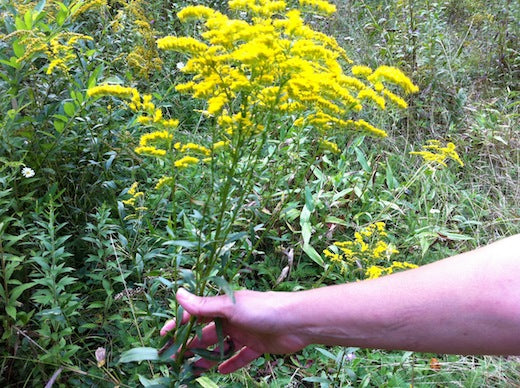Backyard Survival Herbs - Goldenrod's Bum Rap


WAIT, GOLDENROD IS GOOD??
Back when the colonists dumped all the tea in the Boston Harbor, it wasn’t long until they discovered a great substitute: you guessed it! Goldenrod! They called it Liberty Tea! Just knowing that makes me want to go brew some up! The Native Americans, who’d been drinking it for years medicinally, must’ve thought the colonists rather daft to just be drinking it for pleasure. There’s a lot of folklore around the herb like that it can be used in water dowsing and that it is an indicator of where fortunes are to be found (Phew! If that were true, I’d be a millionaire!), but in reality, it has been used medicinally from as far back as the 12th century where The Great Saladin was purported to have required it among his medicinals and when he wasn’t busy fighting in the 3rd crusade, introduced it to the Middle East as an important crop. It has been prevalent in Europe for centuries, where most of the medicinal varieties grow prolifically.
GOLDENROD WAS ALMOST- GOLDEN
Now here’s something I recently learned that I must just include for fun. Thomas Edison conducted experiments with goldenrod because it has a naturally-occurring rubber content of about 7% in the leaves! I guess the rubber couldn’t be upgraded from its tacky, weaker quality to be used extensively, as they hoped during research during WWII, but ‘supposedly’ Henry Ford gave Edison a Model T with rubber tires made from goldenrod! I think if they all would’ve discovered elderberries, it really could’ve worked! (Any of you who have worked with elderberries know of the VERY rubbery ochre-colored residue they make.)
CHEW TWO SPRIGS OF GOLDENROD AND CALL ME IN THE MORNING
Now that we have cleared up some of your misconceptions, let’s reinstate our hapless victim to its real honor as a medicinal herb. The botanical name Solidago comes from the Latin term ‘solidare’ which means to make whole. Ironically, one of its main areas of efficacy is for upper respiratory catarrh! The very thing it has been wrongly blamed for causing! Historically, it has also been used as a diuretic, a diaphoretic, an anti-inflammatory, an antiseptic and an astringent. It can also be combined with other herbs to treat influenza. As a urinary antiseptic, it is amazing, helping to clear up bladder and urinary tract infections as well as dissolve kidney stones. Topically, it can be a wound healing agent and as a gargle, its properties are invaluable. Goldenrod also had carminative properties – which basically means that the oils in the herb help your digestive system to function more at ease and reduce gas. Did you know that you can just munch on the leaves in the wild? – You’ll be reminded of the flavor of anise, which also comes through when you brew it. If you have a toothache or a sore throat, go out and chew on some!
There are many species of goldenrod and so the key thing to look for is yellow flowers in somewhat dense tufts, layed out on a nice tall (2-3 feet) stem. It is commonly found in fallow fields, bottomland, rocky outcrops, open woods, roadsides and railroads in the late summer months through fall. The best time to collect goldenrod is before the flowers bloom, when you want to gather the entire stalks, haul them home and dry them hanging upside down in a shady, cooler place. I like to hang a cut-off paper bag over my herbs to keep the dust from gathering on them. When dried, break the aerial parts up and store in airtight glass jars where they will be ready for you to use in making teas, tinctures, salves and poultices. Though it is traditionally used most as a tea and tincture, the herb can also be infused with other herbs to make wound salves and I wouldn’t hesitate to try a warm goldenrod poultice on either a burn, an ache or a wound. And to top off the usefulness of this herb – if you are artsy, you can derive a beautiful golden dye/paint from the flowers!
HOW TO GET GOLDENROD WHEN IT'S OUT OF SEASON?
As with most herbs, there are optimal times of the year for harvesting. But what if it's not summer where you are and you want some Goldenrod for your home herbal kit? Easy enough... Goldenrod is readily available online as an extract, compound, in teas or even raw, for affordable prices. Here's a link... Have fun! ~Carin
Disclaimer: Of course we claim no responsibility for your experience with these herbs. Everything we share is for information purposes only and is not to be taken as professional or medical advice. Do your own research! Always consult a professional. Be wise. Consider always the chance of an allergic reaction. We are all unique in body chemistry. We are NOT a medical professionals by any means, however we have saved our family a boatload of annoyance and money by being resourceful and using what is right at our feet – literally. See full disclaimer here.




Leave a comment